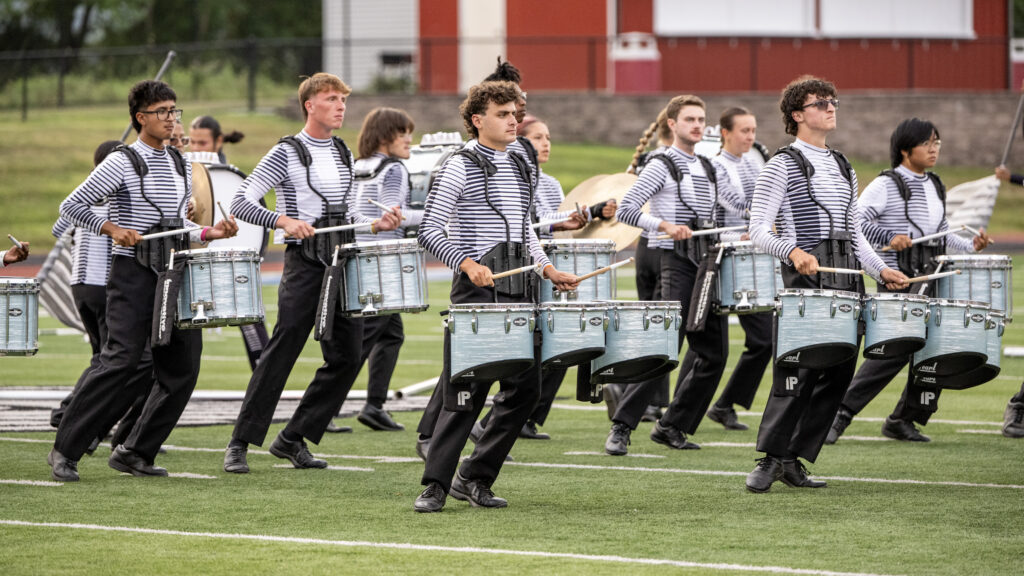If you wanted to boil down Blue Devils’ 2017 production to a word or phrase, you easily could.
A many-layered design that — through a variety of metaphors, visual and musical references, and subtle nods — paid homage to the Concord corps’ 60th anniversary, “Metamorph,” may not have appeared simplifiable on its surface. But it was.
In short, “Metamorph” was about life’s one great constant — change.
“‘Metamorph’ was intended to be a way to acknowledge the 60th anniversary of the Blue Devils and the organization,” program coordinator Scott Chandler said. “It was all about evolution — things that grow, things that change.”
On its simplest level, Blue Devils’ 2017 program utilized natural imagery to signify the cyclical act of change — caterpillars turning to butterflies, coal being forged into diamonds, things of that nature.
But “Metamorph” dug deeper. It ventured across a timeline of six decades, and for audiences across the DCI Tour, artistically outlined a journey from the earliest days of Blue Devils — and drum corps itself — through the corps’ and activity’s present, and to its yet-to-come.
“‘Metamorph’ is a journey from past to future,” music director and arranger Dave Glyde said.
2017 Blue Devils | “Metamorph”
1st Place, 98.538
“Ladies and gentlemen, the corps on the field…”
The first noise of any kind heard at the outset of “Metamorph” was a voice.
Ringing out from the front speakers, the voice of Blue Devils founder Jerry Seawright set the table for what had been the corps’ very first competitive performance in its existence. It wouldn’t be Seawright’s final appearance in the 12 minutes that followed.
With Seawright’s introduction, his corps’ horn line executed an “off-the-line,” emerging onto the field in a single straight line, with members of the color guard all leading the way, rifles spinning in hand, in unison.
The corps’ founder continued.
“This is their first year in competition; this is their very first field show…”
At this point of the show, Blue Devils’ brass and percussion sections were dressed in long blue jackets with white trim, black shakos with tall white plumes, and black pants. Color guard members wore long, flowing, black and light blue covers that would eventually be removed to reveal an array of colors and fabrics.

In an opening segment which Glyde described as a “mosaic,” a handful of soloists, a brooding passage of front ensemble music, and an add-on snare feature — performed by Blue Devils’ entire snare and tenor drum sections, for a total of 16 players — opened the show as brass and color guard members continued to make their way toward center stage.
The snares’ music and motion was rigid in nature, but morphed over the passage of measures, making its way to a more modern style of percussion writing. Similarly, the visual “off-the-line” taking place wasn’t fully true-to-history either; with dance-oriented movement, it broke apart, stitched back together, expanded, compressed, and eventually disintegrated into a follow-the-leader movement and scattered jazz running.
Before their eyes, in one opening movement, audiences were watching decades of drum corps history evolve, musically and visually. Simultaneously, in some of the subtlest and least subtle of ways, Blue Devils’ concept had been introduced.
“Part one of the show was definitely intended to reflect on where drum corps has been in the past,” Chandler said. “And where the Blue Devils have been in the past.”

When the horn line introduced itself, though — with Peter Graham’s “The Triumph of Time” — it wasn’t nearly as subtle.
“Metamorph” was off and running on a powerful brass impact, with horn line members positioned at the field’s center in the shape of a diamond. At the release of their opening statement, marching performers scattered, leaving the front ensemble to introduce movement No. 2’s soundtrack, Nikolai Rimsky-Korsakov’s “Flight of the Bumblebee.”
This movement’s analogies may have been more underlying than others. According to designers, the use of “Flight of the Bumblebee” — and other visual references to the bumblebee itself — was intended to recognize the hive-like nature of Blue Devils as an organization.
“Every bee that’s come through that hive over time has had a part in where we are today and where we were in the past,” Meehan said.
In the corps’ third movement, Blue Devils embodied an increasingly modern form of drum corps, largely in its visual package.
The corps moved into flowing choreography, increased its integration of prop pieces, and most notably, changed its uniform; for the remaining half of “Metamorph,” Blue Devils removed their shakos and shed their blue outer jackets for a sleek, sleeveless, light blue and pink sparkling top.
The middle segment of the production, Blue Devils’ ballad movement, served as the emotional core of the corps’ 2017 production. Featuring “Everything Must Change” by Bernard Ighner, it was undeniably “Blue Devils” — laidback, groovy, in the pocket, and littered with soloists.
Amidst a sea of scattered props, members slowly danced their way toward the front sideline, just to the right side of the 50-yard-line, culminating in a unified, powerful brass chorus that lit audiences ablaze throughout the entire summer of 2017.
The whole ballad movement was simple — no high-speed drill or stunningly-difficult musical passages — and it tugged at the heart strings. It was intended to pull audiences directly into the here-and-now of the drum corps art form.
“The ballad portion of the show is really where we are existing in the present,” Chandler said. “And we are making those changes that hopefully will move us forward.”
“It’’s where we are,” he added. “We are in a time of change.”
The challenging passages would come next.
Following a polyrhythmic battery percussion break that introduced melody motifs from Rhianna’s “Diamond” — specifically her lyric, “shine bright like a diamond” — Blue Devils’ fourth movement began with a high brass feature that saw all trumpet and mellophone players pick up trumpets.
This was one of many moments to pay homage to Blue Devils productions of years past. The high brass feature’s final bars featured a quote from the corps’ 2014 all-time high-scoring production, “Felliniesque.”
“You’re going to hear a lot of throwbacks musically,” John Meehan said. “You’ll hear little glimpses of motifs that we’ve played in the past.”

A Blue Devils program wouldn’t be a Blue Devils program without a jazzy brass shout, and the show’s fifth movement included just that, with a glissando-heavy trombone feature to boot. The corps’ energetic jazz moment transitioned directly into its closing push, which brought all the pieces together.
“The back third of our show is our look at what the future of drum corps might be,” Meehan said. “Obviously no one knows.”
“So, the most we could do was take ideas that were brewing in our hearts and our heads,” Chandler added, “and try to formulate those into a production that gave us a glimpse into what possibilities might be coming at us in the future.”
Fittingly, the music of the 2014 film, “Interstellar,” a forward-looking story that reaches into galaxies untraveled, provided the source music for front ensemble music that built toward a climactic quotation from Rhianna’s “Diamond” — “You and I, you and I, like diamonds in the sky” — making direct celebratory reference to the corps’ diamond anniversary.
From there, in a resounding final push, the horn line rejoined, echoing the same rising “Interstellar” chords alongside a full complement of percussion.
Soloists positioned atop staircase props simultaneously reprised the central melodies of “Everything Must Change,” while color guard members waved white fabric “wings,” another nod to the corps’ iconic past.
And when all of the above boiled to its emotional and energetic peak, there was the voice of Jerry Seawright waiting to complete his introduction, and provide a reminder of what this entire story had been about:
“…Concord Blue Devils.”
Running the Table
Not much can be said about the 2017 Blue Devils’ competitive season other than that the corps went undefeated, marking the third such season for the Concord corps in the span of six years; Blue Devils also went undefeated in 2012 and 2014.
Blue Devils’ 2017 run wasn’t devoid of intrigue, however. Throughout the summer — which also featured the celebration of Santa Clara Vanguard’s 50th anniversary — the Concord corps and its Bay Area neighbor went head-to-head more than a dozen times, and eventually emerged as the season’s top two World Class contenders.
In late July, the competitive heat ratcheted up several degrees with a string of three photo finishes; Blue Devils outscored Santa Clara Vanguad by just 0.100, 0.013 and 0.350 respectively on back-to-back-to-back nights, during a swing through the southeastern United States.
Ultimately, the Concord corps expanded its advantage in the season’s remaining days, and wound up atop the final rankings by a little less than a point, earning its 18th World Championship title. Blue Devils also took home caption awards for General Effect and Visual Performance.
“Being a world champion is such an indescribable feeling,” Blue Devils mellophone player Trevor Stojanovich said in the afterglow of the corps’ 2017 win. “Being able to represent all the Blue Devils from the past 60 years, is something I never thought I would do. Ever since I was 15 years old, I dreamed of this night, and it’s a dream come true.”





